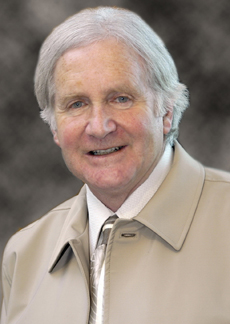School of Architecture remembers Dr Russell Walden
The School of Architecture is this week remembering the life of Dr Russell Walden following his passing last week. Russell taught at the School of Architecture for over 30 years, and will be warmly remembered by many staff and students. The below is a tribute by Prof George Baird, read at the funeral on Tuesday. Other tributes were paid by Emeritus Professor Graeme Fraser, Massey University, and Nick Bevin, Chair of Friends of Futuna.

A Tribute from Prof George Baird
I probably don’t need to tell this congregation that Russell has been an inspiration to us all at the Wellington School of Architecture—almost since its beginning.
The School had its first intake of students in 1975; and the staff numbers built up gradually from then.
We had quickly become a well-integrated group with a wide range of expertise between us—but no architectural historian. Then Russell arrived!
I have to say we were not sure what had hit us—I think some of us even wondered if Founding Professor Gerd Block’s unerring judgement had deserted him for once.
This new recruit was outspoken, extrovert even, certainly not PC, never afraid to let us know his opinions and ask for ours, but clearly passionate about architecture and the education of architects and the role of the university as the conscience of society—in his case the architectural conscience.
A few of us engineers had PhDs but Dr Walden was the only one who had trained as an Architect; and he had one further distinguishing feature in his CV—he had written a book—on Le Corbusier no less—and had it published by MIT Press!!
And didn’t he let us know it—and especially that is wasn’t one of these soft covered jobs—The Open Hand had hard covers— paper backs just didn’t cut it in academic circles according to Russell— an opinion no doubt influenced by his erudite mentors at Birmingham University.
I do remember him recalling with some awe (if you can imagine that of him) the line up of books published by his PhD supervisors. For my own part I can only admire the initiative that took him to Birmingham and the dedication and sheer nerve required to complete a PhD on the work of the revered architect Le Corbusier.
Russell and I were not particularly close in our academic disciplines but I believe there was a sense of mutual respect. Though I suspect it may only have been because my alma mater Glasgow University was 450 years older than the red-brick Birmingham University.
These things mattered to Russell—matters of tradition. He was not a committee person, but somehow found himself on the University’s Ceremonial Committee—probably because he was always complaining that our graduation ceremonies were dull affairs. He became very much involved in transforming our rather staid graduation ceremonies into the wonderful celebrations that we now enjoy.
But getting back to these books. In the early days of the School’s development I am sure that it was Russell’s example that alerted the rest of us of the need to get into print—hard covered print of course.
And so it came to pass—over the next decade or so no less than ten colleagues became published authors or co-authors of hard-covered books. Russell himself kept the pressure on us by adding Voices of Silence and Finnish Harvest to his bookshelf.
I am not suggesting that he was the sole source of motivation for the School’s outstanding publication record, but he had demonstrated it could be done and how it was done—all you needed was an ambitious concept and a willing publisher followed by years of dedicated research and persistent effort .
And of course that’s what Russell did right to the end—Triumphs of Change was a long time coming, but we all knew it would happen. This was his magnum opus—a fitting climax to a long career—embodying the distilled wisdom of a lifetime’s study of architectural history.
And trust Russell to revisit and challenge “Commodity, Firmness and Delight”—the 2000 year old definition of the essential qualities of building attributed to Vitruvius.
In Triumphs of Change Russell has come up with a new set of values—those of “Sense, Sagacity and the Sublime”—I trust these will live on for 2000 years too.
Russell we thank you for your contribution and your inspiration, but most of all for your passion for architecture.
